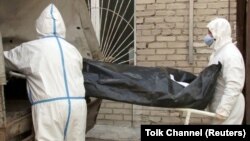President Vladimir Putin was hopeful in remarks on May 10 about the coronavirus pandemic in Russia.
“The situation with the virus in the country, according to specialists, is stable,” he said in Sochi, urging Russians to get vaccinated.
According to official statistics as of May 12, there have been 4,905,059 coronavirus infections in the country and 114,331 fatalities. Those numbers, however, are widely regarded as severely understated.
Deputy Prime Minister Tatyana Golikova acknowledged in December that the country’s data was questionable. She estimated that 81 percent of the 229,700 “excess deaths” that Russia, according to official numbers, experienced in the first 11 months of 2020 could be attributed to COVID-19. That means the death toll would have been more than 186,000, while the Rosstat statistics agency was reporting a pandemic death total of just 57,000 at the time.
Prominent Russian demographer Aleksei Raksha thinks even those numbers are unrealistic, indicating that the true scope of the pandemic in Russia may never be known.
“It is simply a fact that we do not know how many infections we have had,” Raksha told RFE/RL, adding that methods of estimating the number of infections in the absence of large-scale epidemiological studies are far from ideal. “It is all just guesswork. I think that in Russia, no less than one-third of the population has had the virus…. In Moscow and St. Petersburg, the figure is closer to 40 percent. That is my estimate.”
That would put the total figure for coronavirus infections since the pandemic hit early in 2020 at over 47 million.
A Matter Of Priorities
Furthermore, Raksha argues that the government prioritized its political goals over coping with the public-health emergency in the crucial months of the first half of 2020. The Kremlin proceeded with a controversial national plebiscite on a raft of constitutional amendments in June and July 2020, a package that included a provision that could keep Putin in power until 2036 by allowing him to run for two more six-year terms.
“The problem in Russia is not how many people died, but how many people were infected. And so many people were infected because we had powerful propaganda and people were duped because the tsar had to reset himself to zero,” he said, referring to the amendment that allows Putin to run again by stating that the four terms he will have served by 2024 do not count toward the constitutional two-term limit. “This is our main problem.”
“Our government, for the sake of its own goals, threw away the lives of about 300,000 people,” he added. “Of course, most of them were elderly, but they were nonetheless thrown away. If everything had been done properly, our excess deaths would have been a maximum of 150,000 to 200,000, instead of half a million.”
The plebiscite itself was problematic from the epidemiological point of view, and it also provoked a major wave of protest actions across the country.
Raksha was fired from his post as a health demographer at Rosstat in July 2020 for disputing how the country was counting its coronavirus fatalities. At the time, Russia officially had 11,439 COVID-19 deaths, a figure that government officials were using to argue that the state’s response to the emergency had been effective. Raksha insisted at the time that “at least 30,000 people have died due to the coronavirus.”
He continues to rail against the government’s numbers.
“I categorically do not recommend that nonspecialists look at the data from Stopkoronavirusa and Rospotrebnadzor,” he said, referring to the government’s official website of statistics on the pandemic and the state consumer-protection agency, which also reports coronavirus numbers. “You need to forget they even exist because it is harmful. It is simply disinformation.”
Under pressure from Rosstat, he asserted, regional officials have been producing “statistics” out of thin air.
“When they post daily numbers on infections that are practically identical from one day to the next, that is a clear indication that these so-called ‘statistics’ are just made up in their heads…by officials who called Moscow or neighboring regions and agreed on figures,” he said, adding that the numbers were again “evened out” by Rosstat before being published. “These are purely creative numbers...and the talent of these artists is not very impressive.”
Demographic Reversal
Raksha notes that the coronavirus pandemic was a considerable setback to Putin’s longtime goal of improving the country’s demographic situation. In the period from 2006 until 2019, the government managed to raise life expectancy in Russia by 8 1/2 years.
The pandemic, however, reduced life expectancy by 1.8 years, bringing the country back to the levels of 2014-15. Women, he said, suffered disproportionately, perhaps because “in the educational and medical fields and in retail, most of the workers are women.”
“They had a larger chance of becoming infected and, consequently, of dying,” he said.
This reversal of Russia’s population growth must be taken into consideration when calculating the country’s “excess deaths.” By simply comparing the number of deaths in 2020 with the figure from 2019, “we underestimate the excess deaths,” Raksha said.
In addition, he notes, the first quarter of 2020 actually saw 13,000 fewer deaths than the same period in 2019, indicating that Russia was on its way to posting another year of demographic improvement before the pandemic hit. Taking these factors into consideration, Raksha estimates Russia’s excess deaths for 2020 at about 355,000, and he puts the figure for the entire pandemic so far at about 500,000.
He said he believes all the excess deaths can be attributed directly or indirectly to COVID-19. The government has reported that deaths from causes totally unrelated to the pandemic -- accidents, suicides, murders, poisoning, cancer, AIDS, tuberculosis, and others -- fell in 2019. Child mortality also decreased.
“But we know from medics that [COVID-19] strongly affects illnesses of the circulatory and respiratory systems, as well as those of the digestive system,” he told RFE/RL. “But Golikova has not reported on the dynamic of these classes of causes of death, which means that it went up. I think the Health Ministry has reclassified a large portion of the COVID-19 fatalities to other causes.”
“They are lying to us as if we are morons and suckers,” he concluded. “And that is how they treat us: ‘Well, the slaves are dying and dying.’ That’s the way it seems to me.”















